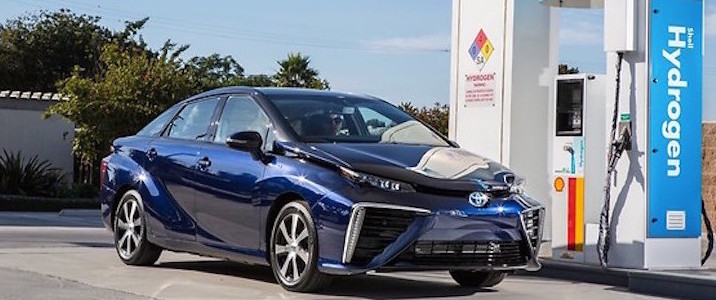Toyota shares technical details of its fuel cell R&D
At the Society of Automotive Engineers (SAE) 2016 World Congress last week, Toyota presented three new papers that share valuable knowledge and insights into the technical development of its fuel cell platform, furthering Toyota’s efforts to support hydrogen-based electromobility throughout the industry.
One paper focuses on the broader systems integration advancements in the new Toyota Mirai, compared to its earlier fuel cell hydrogen vehicle (FCHV) launched on a limited lease basis in 2008. The new system is more compact, modular and shares power control and battery design with Toyota’s hybrid platform, significantly reducing cost. Among the changes are:
Elimination of the external humidifier: In proton exchange membrane (PEM) fuel cells, the humidity of the electrolyte membrane must be controlled to ensure sufficient proton conductivity; this function is usually performed by an external humidifier. To eliminate the external humidifier, Toyota migrated water generated at the cathode to the anode, where it uniformly distributed the water onto the surface of the anode membrane electrode assembly. This was done by developing innovative technology for the stack structure, as well as modifying the anode operating conditions.
Simplified stack structure: Toyota reduced the thickness of the electrolyte membrane, promoting the diffusion of the water in the air system. It humidified the system using moisture at the anode, which also humidifies the cathode inlet by flowing H2 and air in opposite directions. Evaporation was reduced by increasing coolant flow at the cathode inlet. At the anode, Toyota increased the amount of H2 circulation based on driving conditions. Reducing the anode inlet pressure after ensuring the required amount of circulation promotes the evaporation of moisture and enhances the movement of generated water onto the anode surfaces. Slick!
Reduced H2 storage capacity: Fuel economy in the new Mirai was improved by 20 per cent compared to the previous FCHV model, achieving a driving range comparable to conventional gasoline-powered cars. This was done partly by reducing H2 “crossover,” referring to the permeation of H2 from the anode through the electrolyte membrane to the cathode. The H2 circulation pump is used to maintain optimal concentrations at the anode, countering crossover. This is crucial to enabling the removal of the external humidifier, because a much thinner electrolyte membrane can be used. The number of fuel cell tanks has thus been reduced from four to two.
The authors of this paper note:
To encourage the widespread adoption of FCVs, it is necessary to reduce the vehicle price, build an extensive hydrogen infrastructure, and enhance vehicle appeal. The technologies described in this paper enhanced the freedom of vehicle packaging by reducing the size of the system, and ensured that the Mirai has an equivalent cruising range to gasoline vehicles. (Hasegawa, et al., 2016)
The other two Toyota papers presented during the SAE World Congress were less specific to vehicle systems design, and more focused on the general challenges of enhancing the performance of the fuel cell electrode catalyst, as well as providing insight on the degradation process.
The Tech-K.O. Takeaway: Toyota is sharing information that can help its competitors improve their fuel cell systems design. This is commendable; it showcases the company’s technological sophistication, as well as its social values in action.
- Full story at Green Car Congress.
- Sources:
- Hasegawa, T., Imanishi, H., Nada, M., and Ikogi, Y. (2016) “Development of the Fuel Cell System in the Mirai FCV,” SAE Technical Paper 2016-01-1185 doi: 10.4271/2016-01-1185.
- Mizutani, N. and Ishibashi, K. (2016) “Enhancing PtCo Electrode Catalyst Performance for Fuel Cell Vehicle Application,” SAE Technical Paper 2016-01-1187 doi: 10.4271/2016-01-1187.
- Kato, H. (2016) “In-Situ Liquid TEM Study on the Degradation Mechanism of Fuel Cell Catalysts,” SAE Int. J. Alt. Power. 5(1) doi: 10.4271/2016-01-1192.
- Photo: The hydrogen fuel cell-powered Toyota Mirai (auto.ria.com).

